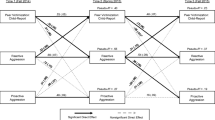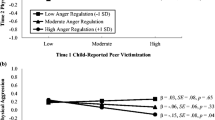Abstract
The current study examined whether social problems accounted for the relation between reactive aggression and withdrawn/depressed symptoms in a sample of 147 children (54.4% male) ranging from 5 to 13 years of age (M = 8.22 years) who attended a community based after-school program. Findings suggested that indeed social problems mediated the link between reactive aggression and withdrawn/depressed symptoms, such that high levels of reactive aggression are associated with high levels of social problems, which in turn are associated with high levels of withdrawn/depressed symptoms. Findings suggest the need to target peer relationships in the prevention of subsequent negative emotions for children who exhibit high levels of reactive aggression.

Similar content being viewed by others
References
Achenbach, T. M., & Rescorla, L. A. (2001). Manual for the ASEBA school-age forms and profiles. Burlington, VT: University of Vermont Department of Psychiatry.
Bandura, A. (1973). Aggression: A social learning analysis. Englewood Cliffs, NJ: Pretince-Hall.
Bender, H. L., Allen, J. P., McElhaney, K. B., Antonishak, J., Moore, C. M., Kelly, H. O. B., et al. (2007). Use of harsh physical discipline and developmental outcomes in adolescence. Development and Psychopathology, 19(1), 227–242.
Berkowitz, L. (1978). Whatever happened to the frustration-aggression hypothesis? American Behavioral Scientist, 32, 691–708.
Berkowitz, L. (1989). Frustration-aggression hypothesis: Examination and reformulation. Psychological Bulletin, 106, 59–73.
Bierman, K. L. (2004). Peer rejection: Developmental processes and intervention strategies. New York: Guilford.
Card, N. A., & Little, T. D. (2006). Proactive and reactive aggression in childhood and adolescence: A meta-analysis of differential relations with psychosocial adjustment. International Journal of Behavioral Development, 30, 466–480.
Card, N. A., & Little, T. D. (2007). Differential relations of instrumental and reactive aggression with maladjustment: Does adaptivity depend on function? In P. H. Hawley, T. D. Little, & P. C. Rodkin (Eds.), Aggression and adaptation: The bright side to bad behavior (pp. 107–134). Mahwah, New Jersey: Lawrence Erlbaum.
Coie, J. D., & Dodge, K. A. (1998). Aggression and antisocial behavior. In W. Damon & N. Eisenberg (Eds.), Handbook of child psychology: Vol 3, social, emotional, and personality development (pp. 779–862). New York: Wiley.
Conner, K. R., Duberstein, P. R., Conwell, Y., & Caine, E. D. (2003). Reactive aggression and suicide: Theory and evidence. Aggression and Violent Behavior, 8, 413–432.
Day, D. M., Bream, L. A., & Pal, A. (1992). Proactive and reactive aggression: An analysis of subtypes based on teacher perceptions. Journal of Clinical Child Psychology, 21, 210–217.
Dodge, K. A., & Coie, J. D. (1987). Social-information-processing factors in reactive and proactive aggression in children’s peer groups. Journal of Personality and Social Psychology, 53, 1146–1158.
Dodge, K. A., Pettit, G. S., & Bates, J. E. (1994). Socialization mediators of the relation between socioeconomic status and child conduct problems. Child Development, 65, 649–665.
Dodge, K. A., Lochman, J. E., Harnish, J. D., Bates, J. E., & Pettit, G. S. (1997). Reactive and proactive aggression in school children and psychiatrically impaired chronically assaultive youth. Journal of Abnormal Psychology, 106, 37–51.
Dodge, K. A., Lansford, J. E., Burks, V. S., Bates, J. E., Pettit, G. S., et al. (2003). Peer rejection and social information-processing factors in the development of aggressive behavior problems in children. Child Development, 74(2), 374–393.
Fite, P. J., Colder, C. R., Lochman, J. E., & Wells, K. C. (2007). Pathways from proactive and reactive aggression to substance use. Psychology of Addictive Behaviors, 21, 355–364.
Fite, P. J., Colder, C. R., Lochman, J. E., & Wells, K. C. (2008). The relation between childhood proactive and reactive aggression and substance use initiation. Journal of Abnormal Child Psychology, 36, 261–271.
Fite, P. J., Stoppelbein, L., & Greening, L. (2009). Proactive and reactive aggression in a child psychiatric inpatient population. Journal of Clinical Child and Adolescent Psychology, 38, 199–205.
Fite, P. J., Raine, A., Stouthamer-Loeber, M., Loeber, R., & Pardini, D. A. (2010). Reactive and proactive aggression in adolescent males: Examining differential outcomes 10-years later in early adulthood. Criminal Justice and Behavior, 37, 141–157.
Gershoff, E. T. (2002). Corporal punishment by parents and associated child behaviors and experiences: A meta-analytic and theoretical review. Psychological Bulletin, 128(4), 539–579.
Gilman, S. E., Kawachi, I., Fitzmaurice, G. M., & Buka, S. L. (2003). Family disruption in childhood and risk for adult depression. American Journal of Psychiatry, 160, 939–946.
Grube, M. (2004). Which types of aggressive behavior are associated with suicidal and self-injurious behaviour at the time of admission? Psychopathology, 37, 41–49.
Kline, R. B. (2005). Principles and practice of structural equation modeling, 2nd edition. New York: Guilford Press.
Lochman, J. E., & Wayland, K. K. (1994). Aggression, social acceptance, and race as predictors of negative adolescent outcomes. Journal of the American Academy of Child and Adolescent Psychiatry, 33, 1026–1037.
MacKinnon, D. P., Lockwood, C. M., & Williams, J. (2004). Confidence limits for the indirect effect: Distribution of the product and resampling methods. Multivariate Behavioral Research, 39, 99–128.
Miller, J. D., & Lynam, D. R. (2006). Reactive and proactive aggression: Similarities and differences. Personality and Individual Differences, 41, 1469–1480.
Muthen, L. K., & Muthen, B. (2008). Mplus: The comprehensive modeling program for applied researchers. Los Angeles, CA: Muthen & Muthen.
Price, J. M., & Dodge, K. A. (1989). Reactive and proactive aggression in childhood: Relations to peer status and social context dimensions. Journal of Abnormal Child Psychology, 17, 455–471.
Prinstein, M. J., & Aikins, J. W. (2004). Cognitive moderators of the longitudinal association between peer rejection and adolescent depressive symptoms. Journal of Abnormal Psychology, 32(2), 147–158.
Prinstein, M. J., Boergers, J., Spirito, A., Little, T. D., & Grapentine, W. L. (2000). Peer functioning, family dysfunction, and psychological symptoms in a risk factor model for adolescent inpatients’ suicidal ideation severity. Journal of Clinical Psychology, 29(3), 392–405.
Prinstien, M. J., & Cillessen, A. H. N. (2003). Forms and functions of adolescent peer aggression associated with high levels of peer status. Merrill-Palmer Quarterly, 49, 310–342.
Raine, A., Dodge, K. A., Loeber, R., Gatzke-Kopp, L., Lynam, D., Reynolds, C., et al. (2006). The reactive-proactive aggression questionnaire: differential correlates of reactive and proactive aggression in adolescent boys. Aggressive Behavior, 32, 159–171.
Shields, A., & Cicchetti, D. (1998). Reactive aggression among maltreated children: The contributions of attention and emotion dysregulation. Journal of Clinical Child Psychology, 27, 381–395.
Vitaro, F., Brendgen, M., & Tremblay, R. E. (2002). Reactively and proactively aggressive children: antecedent and subsequent characteristics. Journal of Child Psychology and Psychiatry, 43, 495–505.
Waschbusch, D. A., Willoughby, M. T., & Pehlam, W. E. (1998). Criterion validity and the utility of reactive and proactive aggression: Comparisons to attention deficit hyperactivity disorder, oppositional defiant disorder, oppositional defiant disorder, and other measures of functioning. Journal of Clinical Child Psychology, 27, 396–405.
Zahn-Waxler, C., Park, J. H., Essex, M., Slattery, M., & Cole, P. (2005). Relational and overt aggression in disruptive adolescents: prediction from early social representations and links with concurrent problems. Early Education and Development, 16(2), 259–282.
Author information
Authors and Affiliations
Corresponding author
Rights and permissions
About this article
Cite this article
Fite, P.J., Rathert, J.L., Stoppelbein, L. et al. Social Problems as a Mediator of the Link Between Reactive Aggression and Withdrawn/Depressed Symptoms. J Child Fam Stud 21, 184–189 (2012). https://doi.org/10.1007/s10826-011-9461-4
Published:
Issue Date:
DOI: https://doi.org/10.1007/s10826-011-9461-4




